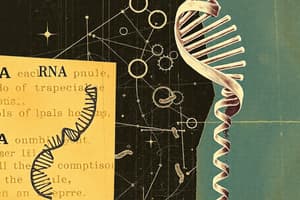Podcast
Questions and Answers
What is one main difference between RNA and DNA?
What is one main difference between RNA and DNA?
- DNA has Uracil, while RNA has Thymine
- RNA can leave the nucleus, while DNA cannot (correct)
- Both are the same size
- RNA is larger than DNA
What are the four bases of RNA?
What are the four bases of RNA?
Adenine, Guanine, Cytosine, Uracil
Which of the following is a similarity between DNA and RNA?
Which of the following is a similarity between DNA and RNA?
- They are both single-stranded
- They both have Thymine
- They both are nucleic acids (correct)
- They both are found only in the cytoplasm
What is one difference between animal cells and plant cells?
What is one difference between animal cells and plant cells?
Which of the following structures is present in plant cells but not in animal cells?
Which of the following structures is present in plant cells but not in animal cells?
Both animal and plant cells are classified as what type of cell?
Both animal and plant cells are classified as what type of cell?
What is one major difference between prokaryotic and eukaryotic cells?
What is one major difference between prokaryotic and eukaryotic cells?
What process do eukaryotic cells undergo for cell division?
What process do eukaryotic cells undergo for cell division?
Flashcards are hidden until you start studying
Study Notes
Differences Between RNA and DNA
- RNA transmits information from DNA to ribosomes for protein production, while DNA transmits genetic information from parent to offspring.
- RNA can leave the nucleus, whereas DNA remains confined within it.
- RNA contains the bases Adenine, Guanine, Cytosine, and Uracil; DNA has Adenine, Guanine, Cytosine, and Thymine.
- RNA is ribonucleic acid, while DNA is deoxyribonucleic acid.
- RNA includes ribose sugar; DNA consists of deoxyribose sugar.
- RNA is smaller, temporary in structure, and does not self-replicate; DNA is larger, permanent, and can self-replicate.
Similarities Between DNA and RNA
- Both are polymers composed of nucleotides.
- Both are classified as nucleic acids.
- Each contains the three common bases: Adenine, Guanine, and Cytosine.
- Both are found within the nucleus of the cell.
- Each has a phosphate group linked to a carbon sugar.
Differences Between Animal Cells and Plant Cells
- Plant cells maintain a rectangular shape, while animal cells are circular.
- Plant cells contain a large central vacuole, contrasting with the small vacuoles in animal cells.
- Plant cells have a rigid cell wall; animal cells lack this feature.
- Chloroplasts are present in plant cells for photosynthesis but absent in animal cells.
- Plant cells do not have centrioles, cilia, or flagella; animal cells possess centrioles and may have cilia/flagella for movement.
- Plant cells typically do not move, while animal cells can move when necessary.
Similarities Between Animal and Plant Cells
- Both cell types undergo division through mitosis.
- Both are classified as eukaryotic, containing complex structures.
- Each type includes essential organelles such as a nucleus, mitochondria, Golgi apparatus, vesicles, and cell membranes.
Differences Between Prokaryotes and Eukaryotes
- Eukaryotic cells are multicellular, while prokaryotic cells are unicellular.
- Eukaryotes have a nucleus bound by a membrane, whereas prokaryotes lack a true nucleus.
- Eukaryotic cells possess present chromosomes and DNA, whereas prokaryotes have plasmids and no true chromosomes.
- Eukaryotic cells contain lysosomes; prokaryotes do not.
- Eukaryotes range in size from 10-100 micrometers; prokaryotes are smaller, typically 1-10 micrometers.
- Examples of eukaryotes include Protista, Fungi, Plantae, and Animalia; prokaryotes fall under the Monera kingdom.
- Eukaryotes reproduce via mitosis, while prokaryotes primarily reproduce through binary fission.
Studying That Suits You
Use AI to generate personalized quizzes and flashcards to suit your learning preferences.




